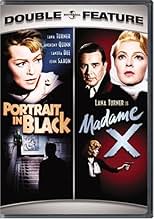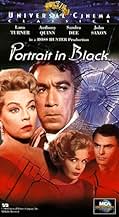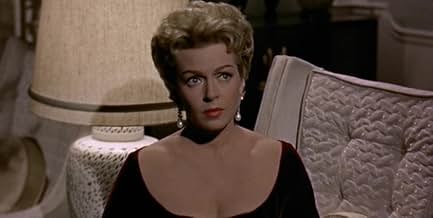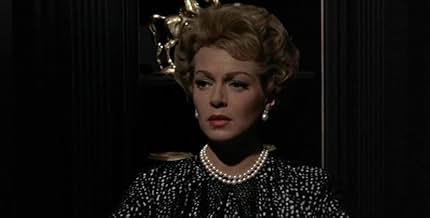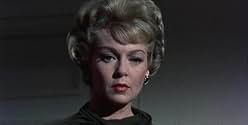NOTE IMDb
6,3/10
2 k
MA NOTE
Après qu'une femme mariée et son amant assassinent son cruel mari, ils se retrouvent pris pour cible par une personne au courant de leur crime.Après qu'une femme mariée et son amant assassinent son cruel mari, ils se retrouvent pris pour cible par une personne au courant de leur crime.Après qu'une femme mariée et son amant assassinent son cruel mari, ils se retrouvent pris pour cible par une personne au courant de leur crime.
- Réalisation
- Scénario
- Casting principal
Avis à la une
Unlike Lana Turner's previous Ross Hunter extravaganza, "Imitation of Life," which had a serious side to it, "Portrait In Black" is pure fun. Once again she plays a glamour puss, decked out in Jean Louis gowns and David Webb jewels just to sit around the house. When she goes shopping at I. Magnin she positively drips in fur. The plot is a quasi-remake of Lana's Hollywood high point, "The Postman Always Rings Twice," in which she conspires with her lover to kill her much-older husband. Unfortunately, Anthony Quinn as her lover is completely miscast. Richard Basehart is much better as her slimy scorned suitor. Sandra Dee shows up again, this time as Lana's stepdaughter with whom she has an icy relationship. Once the murder takes place, Lana receives threatening notes and suspicion is cast on every character, including the maid and chauffeur. Hilarity ensues when, in a throwback to her scene in "The Bad and the Beautiful," she becomes hysterical while driving a car. Enjoy this film on many levels, as a mystery, a feast for the eyes, or an exercise in campy entertainment.
Poor Lana Turner is forced to wear Jean Louis gown after Jean Louis gown in this picture, a veritable sea of sequins. To add insult to injury, she is kept like a bird in a gilded cage in her magnificent Pacific Heights mansion. Her lover (Anthony Quinn) lives only a couple of blocks away, but in order to tryst with him, she must first go down to Union Square and pretend to shop at the old I. Magnin store (now Macy's), then take a cab back out to Divisadero - very inconvenient. An uncommonly silly movie, but great set decoration and use of locations. If you ever come to visit San Francisco, you can see the house that Lana, Sandra and Lloyd lived in; it's at the corner of Broadway and Baker, just about the ritziest neighborhood in town, natch....enjoy!
A beautiful, but faithless woman(Lana Turner) plots with her handsome, but brooding doctor-lover(Anthony Quinn) to murder her sickly husband(Lloyd Nolan). No, there's nothing overly fancy about this suspense melodrama, in fact in content it's quite ordinary. But the movie is given Hollywood's full treatment with striking photography, splendid costuming and decor, and good performances by a capable cast. Trivia: this film reunited IMITATION OF LIFE producer Ross Hunter with that movie's stars Lana Turner and Sandra Dee. Having played mother and daughter in that film, Turner and Dee are stepmother and stepdaughter this time around.
Portrait in Black (1960)
In a beautifully drippy, bleeding, sticky Douglas Sirk mode, and one year after leading lady Lana Turner appeared in Sirk's "Imitation of Life," this highly slick and artificial (and yet moving) melodrama is one of the high points in a low period of Hollywood. The other main character is Anthony Quinn, who is remarkable, too, one of those underrated leading men, I'm not sure why. The two of them are supported by Richard Basehart as a fascinating and chilling underling with a peculiar mysterious cheerfulness, and Sandra Dee, who plays the spoiled daughter all too well (as you can imagine).
Unlike Sirk's dramas, this one, directed by is not just about normal human dramas (soap opera stuff), but adds a criminal and suspense element that kicks in after half an hour. The throbbing music takes on a different meaning here, and the sobbing and regrets make for an intense ride.
The deeper you get into this movie, the deeper the plot gets, with intrigue and worry and more murder mounting. And it's all filmed with fluid, rich, widescreen color photography, with intensely rendered music (that holds nothing back), and with a subtle kind of attention to nuance that oddly adds to the excesses of the plot.
And it's the plot, the story, that is so finely tuned it sustains all this cinematic swaying. It's not like some movies where the music or the photography drives the plot--here they are woven together really well, artfully and emphatically. Quinn and Turner are both extraordinary, lifting what could have been a soap opera to something completely fuller.
Russell Metty, behind the camera, was at the peak of his career, having shot not only "Imitation of Life" the year before but Sirk's early "Written on the Wind" (and moving on quickly to several masterpieces like "Spartacus" and "The Misfits"). And in fact the composer, veteran Frank Skinner, wrote the music for those two classic Sirk films, as well. It's worth stressing all this because Sirk has a huge (and deserved) following, and I have a feeling this one is just under the radar of Sirk fans. If a great Sirk film seems to almost reference itself the way it becomes so perfectly "arch" in its stereotypes, "Portrait in Black" does maintain a sense of being still a film wanting to move a plot idea along (these are subtle differences about style becoming affectation on purpose). But even so, the parallels are extraordinary, and this is a remarkable movie on those terms.
It's worth wondering what else, beyond Sirk, was going on around this time, and in fact, with the murder and suspense here it helps to look at Hitchcock's films "North by Northwest" (1959) and "Vertigo" (1958). Both are clearly influences in filming style, lacking only that higher level of stylized artfulness (and storytelling) that Hitch was by then such a master of. Or then, you might say, there was perhaps the influence of Sirk on Hitchcock, at least in the visual richness and fluidity (something Hitch abandoned immediately, almost making a point, this very year with "Psycho").
Anyway, if you don't mind an over the top melodrama done to perfection, here you go. And for movie fans, check out Anna May Wong's last film appearance (not a great performance, but she's her own legend). See it on the biggest screen you can, too--this doesn't translate well at all to a laptop experience.
In a beautifully drippy, bleeding, sticky Douglas Sirk mode, and one year after leading lady Lana Turner appeared in Sirk's "Imitation of Life," this highly slick and artificial (and yet moving) melodrama is one of the high points in a low period of Hollywood. The other main character is Anthony Quinn, who is remarkable, too, one of those underrated leading men, I'm not sure why. The two of them are supported by Richard Basehart as a fascinating and chilling underling with a peculiar mysterious cheerfulness, and Sandra Dee, who plays the spoiled daughter all too well (as you can imagine).
Unlike Sirk's dramas, this one, directed by is not just about normal human dramas (soap opera stuff), but adds a criminal and suspense element that kicks in after half an hour. The throbbing music takes on a different meaning here, and the sobbing and regrets make for an intense ride.
The deeper you get into this movie, the deeper the plot gets, with intrigue and worry and more murder mounting. And it's all filmed with fluid, rich, widescreen color photography, with intensely rendered music (that holds nothing back), and with a subtle kind of attention to nuance that oddly adds to the excesses of the plot.
And it's the plot, the story, that is so finely tuned it sustains all this cinematic swaying. It's not like some movies where the music or the photography drives the plot--here they are woven together really well, artfully and emphatically. Quinn and Turner are both extraordinary, lifting what could have been a soap opera to something completely fuller.
Russell Metty, behind the camera, was at the peak of his career, having shot not only "Imitation of Life" the year before but Sirk's early "Written on the Wind" (and moving on quickly to several masterpieces like "Spartacus" and "The Misfits"). And in fact the composer, veteran Frank Skinner, wrote the music for those two classic Sirk films, as well. It's worth stressing all this because Sirk has a huge (and deserved) following, and I have a feeling this one is just under the radar of Sirk fans. If a great Sirk film seems to almost reference itself the way it becomes so perfectly "arch" in its stereotypes, "Portrait in Black" does maintain a sense of being still a film wanting to move a plot idea along (these are subtle differences about style becoming affectation on purpose). But even so, the parallels are extraordinary, and this is a remarkable movie on those terms.
It's worth wondering what else, beyond Sirk, was going on around this time, and in fact, with the murder and suspense here it helps to look at Hitchcock's films "North by Northwest" (1959) and "Vertigo" (1958). Both are clearly influences in filming style, lacking only that higher level of stylized artfulness (and storytelling) that Hitch was by then such a master of. Or then, you might say, there was perhaps the influence of Sirk on Hitchcock, at least in the visual richness and fluidity (something Hitch abandoned immediately, almost making a point, this very year with "Psycho").
Anyway, if you don't mind an over the top melodrama done to perfection, here you go. And for movie fans, check out Anna May Wong's last film appearance (not a great performance, but she's her own legend). See it on the biggest screen you can, too--this doesn't translate well at all to a laptop experience.
Adultery, murder, blackmail, and Lana Turner, what more could one ask of a Ross Hunter production? Perhaps a good script, but that would spoil the fun. "Portrait in Black" will have lovers of camp in stitches at dialog that makes daytime soaps seem Shakespearean. The overwrought emoting and melodramatic scenes are often unintentionally funny, and the plot requires Olympian leaps to cross the credibility gaps.
Lana is having an affair with Anthony Quinn, the doctor who is attending her terminally ill husband, Lloyd Nolan, a shipping magnate. Nolan's company, Cabot Lines, is evidently quite successful, because Lana's daily expenditures on wardrobe, coiffures, and makeup would likely sink a ship. The couple's palatial San Francisco home is a Ross Hunter fantasy whose upkeep could sink yet another Cabot Line vessel. Nolan's daughter from a first marriage, Sandra Dee, evidently has her stepmother's taste in clothes and manicure, while the son from his marriage to Lana has to make do with a toy airplane. Throw in a greedy business associate played by Richard Basehart; Dee's suitor, John Saxon; a chauffeur, Ray Walston; and a housekeeper, Anna May Wong; and you have a delicious cast of potential suspects to populate an Agatha Christie mystery. However, "Portrait in Black" is not a whodunit, but rather a "who knows they dun it."
Lana is the ultimate drama queen, and she is in peak form. She suffers, she screams, she cries; she is the empress of high camp. Anthony Quinn, who should have read the script before he signed the contract, plays down to his part and seems to know he has had and will have better parts. Sandra Dee appears to be studying for future Lana Turner roles, while Walston and Wong play their parts with the necessary ambiguity to keep viewers guessing their secrets.
However, despite the overacting, bad writing, and soap opera direction, "Portrait in Black" is great fun for those who love their melodramas with big budgets and great style. Even the obligatory mirror smashing has been incorporated. The movie is enormously entertaining for its sometimes howlingly funny situations, absurd lines, and the sheer pleasure of watching Lana looking and emoting at her best.
Lana is having an affair with Anthony Quinn, the doctor who is attending her terminally ill husband, Lloyd Nolan, a shipping magnate. Nolan's company, Cabot Lines, is evidently quite successful, because Lana's daily expenditures on wardrobe, coiffures, and makeup would likely sink a ship. The couple's palatial San Francisco home is a Ross Hunter fantasy whose upkeep could sink yet another Cabot Line vessel. Nolan's daughter from a first marriage, Sandra Dee, evidently has her stepmother's taste in clothes and manicure, while the son from his marriage to Lana has to make do with a toy airplane. Throw in a greedy business associate played by Richard Basehart; Dee's suitor, John Saxon; a chauffeur, Ray Walston; and a housekeeper, Anna May Wong; and you have a delicious cast of potential suspects to populate an Agatha Christie mystery. However, "Portrait in Black" is not a whodunit, but rather a "who knows they dun it."
Lana is the ultimate drama queen, and she is in peak form. She suffers, she screams, she cries; she is the empress of high camp. Anthony Quinn, who should have read the script before he signed the contract, plays down to his part and seems to know he has had and will have better parts. Sandra Dee appears to be studying for future Lana Turner roles, while Walston and Wong play their parts with the necessary ambiguity to keep viewers guessing their secrets.
However, despite the overacting, bad writing, and soap opera direction, "Portrait in Black" is great fun for those who love their melodramas with big budgets and great style. Even the obligatory mirror smashing has been incorporated. The movie is enormously entertaining for its sometimes howlingly funny situations, absurd lines, and the sheer pleasure of watching Lana looking and emoting at her best.
Le saviez-vous
- AnecdotesFinal film of Anna May Wong.
- GaffesAlthough Mason is shown driving a 1959 Dodge Custom Royal Lancer, the car that goes over the cliff is a less expensive 1958 Dodge Coronet Lancer. And, when it goes over the cliff, extensive front-end damage can be seen, meaning this was probably a wrecked car the studio purchased just for this scene.
- Citations
Sheila Cabot: Oh don't leave me David, please don't go away!
Dr. David Rivera: I've got to go!
Sheila Cabot: But why Darling, why? I don't know what I'll do if you go!
Dr. David Rivera: I'm - I'm afraid of what I'll do if I stay!
- ConnexionsEdited into The Green Fog (2017)
Meilleurs choix
Connectez-vous pour évaluer et suivre la liste de favoris afin de recevoir des recommandations personnalisées
- How long is Portrait in Black?Alimenté par Alexa
Détails
- Date de sortie
- Pays d’origine
- Langue
- Aussi connu sous le nom de
- Portrait in Black
- Lieux de tournage
- San Francisco, Californie, États-Unis(sequence at Devil's Slide on the Pacific Coast Highway - State Route 1)
- Société de production
- Voir plus de crédits d'entreprise sur IMDbPro
Box-office
- Budget
- 1 400 000 $US (estimé)
- Durée
- 1h 52min(112 min)
Contribuer à cette page
Suggérer une modification ou ajouter du contenu manquant



